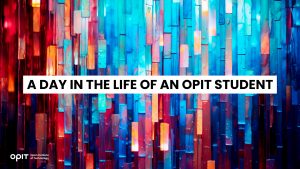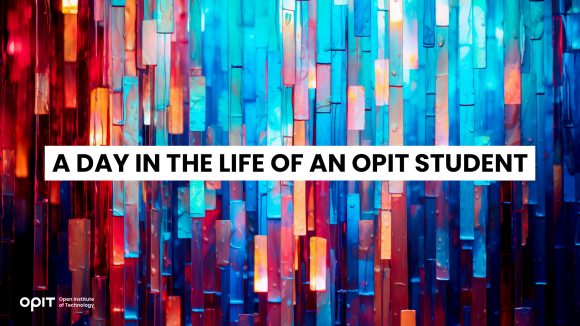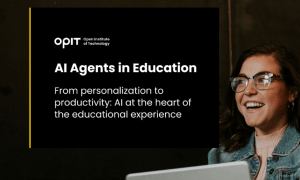

When it comes to traditional classroom learning, every day looks pretty much the same. You commute to your lectures, sit in a designated classroom, engage with your instructors and peers, and go home and study. This repetitive grind often leaves students yearning for a more dynamic and flexible educational experience.
Enter online learning.
When you study online, you have the freedom to craft your own schedule, escape the confining classroom setting, and explore diverse learning materials at your own pace.
Of course, this doesn’t mean your day shouldn’t be structured and well-organized. It just means that online learning firmly puts the reins of your education in your hands, allowing you to decide when, where, and how you engage with your coursework.
With this in mind, let’s explore what a day in the life of an Open Institute of Technology (OPIT) student might look like.
How an OPIT Student Spends an Average Day
Before diving into the specifics, let’s get to know the online “classroom” OPIT students spend most of their days at – Canvas LMS (Learning Management System).
Canvas LMS is the world’s No. 1 teaching and learning software, revolutionizing the educational experience for OPIT students. This robust LMS serves as a virtual hub for all academic activities, from live lectures to discussion boards.
Canvas LMS checks all the boxes for an enjoyable learning experience – it’s user-friendly, easy to navigate, interactive, and adaptable. Talk about a superior alternative to a traditional classroom!
Without further ado, let’s visit this platform and commence our day of immersive virtual classes, interactive discussions, and self-paced study sessions.
1. Log In to the Canvas LMS
The great thing about online education is that you can start your day whenever you’d like. Still, most OPIT students visit their Canvas account in the morning to check important updates, assignments, and announcements. Of course, this visit can also jog their memory about upcoming deadlines and live sessions.
But doesn’t the platform get confusing with all these different elements?
Absolutely not!
Here’s a quick breakdown of what OPIT students see once they log in.
First up – the dashboard. This centralized hub provides a neat overview of all the courses our students are enrolled in. So, for instance, if the student is pursuing a Master’s Degree (MSc) in Enterprise Security, they’ll see courses like “Cybersecurity Fundamentals and Governance,” “Data Analytics and Risk Management,” and “Cryptography and Secure Communications.”
On the right, next to the dashboard, students can see all their to-do activities, such as live lectures, study sessions, and student mixers. With this handy list, OPIT allows students to always stay on top of their game, as keeping a to-do list is a huge must in online learning.
If we were to go to the left, we’d see an easy-to-follow menu with tabs like “Courses,” “Inbox,” and “Help.” But these don’t come into play just yet. OPIT students typically first check their “Calendar” tab.
Though keeping tabs on all the activities in the calendar is essential for a productive day, our students typically prioritize two – live sessions and assessments (with their due dates).
When there’s a live session, the entire day is centered around it to ensure active participation.
Let’s make our fictional day one of these days to make it more interesting. As an example, suppose the lecture starts at 7 p.m., which OPIT students can find out by clicking on the live session in the calendar. There will also be a Zoom link to facilitate easy access when the time comes.
As far as the assessments go, students should always make sure there aren’t any with due dates close together. If there are, they know what to do – tackle them on time and avoid any last-minute stress.
2. Check the Course Content
At this point, our student knows exactly what their day will look like. Since the focus of that day will be on the live session, it’s time to get acquainted with the course content relevant to the upcoming lecture.
A quick click on the course in question, followed by the “Modules” tab, is all it takes to access this content.
The “Module” tab offers a neat overview of all the past and upcoming modules, broken down into theoretical and practical portions. With well-thought-out overviews, PowerPoint presentations, and tutorials, OPIT students can prep for the live session hassle-free.
3. Start Studying
Now that our students know what to expect from the live session, it’s time to get down to focused studying. Since the live session is in the evening, there’s plenty of time to go over the new module, revise the past one(s), and solidify their understanding.
To make the most out of their study time, OPIT students usually plan it in advance, especially when they intend to work on more than one module at a time. This helps them stay on track and avoid the ever-so-tempting procrastination.
As far as the studying itself goes, it’s all up to our students. They can tackle the material in short bursts or dedicate larger blocks of time to focus on the matter at hand. Whatever works for them!
4. Ask for Help
With online learning and self-paced studying, it’s perfectly normal to encounter challenging concepts and have numerous questions in the process. Moreover, these questions don’t necessarily have to do anything with the course material. Students might struggle to organize their time, balance priorities, or adapt to the online learning environment itself. Whatever the case, we’ve got great news – OPIT has an incredible support system in place.
That’s why our students will take some time after their study session to schedule a meeting with Sara Ciabattoni, OPIT’s Class Coordinator. During this 20-minute meeting, they will greatly benefit from Sarah’s expertise and guidance, allowing them to return to their studies with renewed confidence.
Like everything in Canvas LMS, scheduling this meeting takes only a few clicks. Visit the Class Coordinator Virtual Office, choose your preferred date and time, hit “Next,” and you’re good to go. Upon confirmation, Sarah will provide all the necessary conferencing details. Best of all? The meeting will automatically be added to the student’s Google calendar, so there’s no need to deal with these technicalities.
5. Take a Break Before Live Session
At this point, the day has already been filled with lots of helpful activities, productive studying, and valuable preparation. Do you know what this means? That’s right – a break is well-deserved!
During the break, OPIT students can do virtually whatever they want. After all, they’re home or in their chosen environment. Most of them use the break to relax, do something enjoyable, or grab a meal. Some will even use it to change the scenery a little before the live session.
The great news is that Canvas can come with them wherever they go. Canvas LMS offers a nifty app that allows students to check their calendars, see relevant activities, and read notifications on the go. This adds another layer of flexibility to this already incredibly convenient learning experience.
6. Attend the Live Session
Cue a ringing school bell – it’s time for the live session!
By this time, our students have already found the perfect environment to immerse themselves in the live session. Once the session begins, they can actively listen, take notes, or ask questions. OPIT’s amazing faculty is there to facilitate an engaging and interactive learning experience with lots of valuable insights and guidance.
7. Check the Grades
Thanks to the revitalizing break before the live session, our students won’t be too tired for some more work even after the session has concluded. But first – a quick check of the grades.
Unsurprisingly, grades can be accessed in two clicks by visiting the tab of the same name under “Courses”. One more click is all it takes to understand how these grades have been earned.
8. Work on Assessments
Let’s say our student enjoys studying in the evening and has a lot of energy left after the live lecture. In that case, it’s time to tackle some assignments.
Since OPIT continually assesses its students instead of hitting them with one huge final, keeping up with assignments is crucial.
These assignments often call for teamwork, which Canvas makes easy. A visit to the “Collaborations” tab under “Courses” and a click on the “Start a New Collaboration” button can be the beginning of an incredibly fruitful collaboration.
OPIT students typically use WhatsApp to communicate outside the “official” Canvas and Slack platforms, so a quick message is enough to get all the teammates together.
9. Talk to a Career Advisor
OPIT students nearing the end of their academic journey at our institution typically have important decisions to make regarding their career paths. That’s why it’s perfectly normal to feel slightly anxious or overwhelmed at the end of the day.
So, let’s schedule a valuable one-on-one consultation with the Head of Career Services at OPIT before signing off. The unbelievably experienced Mike McCulloch is at our student’s disposal for any career-related concerns, guidance, or support.
10. Revel in a Day Well-Spent
At the end of such a day, all our students can do is pat themselves on the back. Here at OPIT, we’d like to believe we also have a part in this sense of achievement, thanks to the unparalleled flexibility, clarity, and support we offer.
But what will your typical day as an OPIT student look like? Start your academic journey at this prestigious institution to find out.
Related posts

Source:
- Times of Malta, published on September 18th, 2025
4 min read
The gathering brought together academics and technology leaders from prominent European Institutions, such as Instituto de Empresa (IE University), OPIT itself and the Royal College of Arts, to explore how artificial intelligence is reshaping the university experience.
The OPIT AI Copilot has been trained on the institute’s complete academic archive, a collection created over the past three years that includes 131 courses, more than 3,500 hours of recorded lectures, 7,500 study resources, 320 certified assessments, and thousands of exercises and original learning documents.
Unlike generic AI tools, the Copilot is deeply integrated with OPIT’s learning management system, allowing it to track each student’s progress and provide tailored support.
This integration means the assistant can reference relevant sources within the learning environment, adapt to the student’s stage of study, and ensure that unreleased course content remains inaccessible.
A mobile app is also scheduled for release this autumn, that will allow students to download exercise and access other tools.
During examinations, the Copilot automatically switches to what the institute calls an “anti-cheating mode”, restricting itself to general research support rather than providing direct answers.
For OPIT’s international community of 500 students from nearly 100 countries, many of whom balance studies with full-time work, the ability to access personalised assistance at any time of day is a key advantage.
“Eighty-five per cent of students are already using large language models in some way to study,” said OPIT founder and director Riccardo Ocleppo. “We wanted to go further by creating a solution tailored to our own community, reflecting the real experiences of remote learners and working professionals.”
Tool aims to cut correction time by 30%
The Copilot will also reduce administrative burdens for faculty. It can help grade assignments, generate new educational materials, and create rubrics that allow teachers to cut correction time by as much as 30 per cent.
According to OPIT, this will free up staff to dedicate more time to teaching and direct student engagement.
At the Milan event, Rector Francesco Profumo underlined the broader implications of AI in higher education. “We are in the midst of a deep transformation, where AI is no longer just a tool: it is an environment that radically changes how we learn, teach, and create,” he said.
“But it is not a shortcut. It is a cultural, ethical, and pedagogical challenge, and to meet it we must have the courage to rethink traditional models and build bridges between human and artificial intelligence.”
OPIT was joined on stage by representatives from other leading institutions, including Danielle Barrios O’Neill of the Royal College of Art, who spoke about the role of AI in art and creativity, and Francisco Machin of IE University, who discussed applications in business and management education.
OPIT student Asya Mantovani, also employed at a leading technology and consulting firm in Italy, gave a first-hand account of balancing professional life with online study.
The assistant has been in development for the past eight months, involving a team of OPIT professors, researchers, and engineers.
Ocleppo stressed that OPIT intends to make its AI innovations available beyond its own institution. “We want to put technology at the service of higher education,” he said.
“Our goal is to develop solutions not only for our own students, but also to share with global institutions eager to innovate the learning experience in a future that is approaching very quickly.”

From personalization to productivity: AI at the heart of the educational experience.
Click this link to read and download the e-book.
At its core, teaching is a simple endeavour. The experienced and learned pass on their knowledge and wisdom to new generations. Nothing has changed in that regard. What has changed is how new technologies emerge to facilitate that passing on of knowledge. The printing press, computers, the internet – all have transformed how educators teach and how students learn.
Artificial intelligence (AI) is the next game-changer in the educational space.
Specifically, AI agents have emerged as tools that utilize all of AI’s core strengths, such as data gathering and analysis, pattern identification, and information condensing. Those strengths have been refined, first into simple chatbots capable of providing answers, and now into agents capable of adapting how they learn and adjusting to the environment in which they’re placed. This adaptability, in particular, makes AI agents vital in the educational realm.
The reasons why are simple. AI agents can collect, analyse, and condense massive amounts of educational material across multiple subject areas. More importantly, they can deliver that information to students while observing how the students engage with the material presented. Those observations open the door for tweaks. An AI agent learns alongside their student. Only, the agent’s learning focuses on how it can adapt its delivery to account for a student’s strengths, weaknesses, interests, and existing knowledge.
Think of an AI agent like having a tutor – one who eschews set lesson plans in favour of an adaptive approach designed and tweaked constantly for each specific student.
In this eBook, the Open Institute of Technology (OPIT) will take you on a journey through the world of AI agents as they pertain to education. You will learn what these agents are, how they work, and what they’re capable of achieving in the educational sector. We also explore best practices and key approaches, focusing on how educators can use AI agents to the benefit of their students. Finally, we will discuss other AI tools that both complement and enhance an AI agent’s capabilities, ensuring you deliver the best possible educational experience to your students.
Have questions?
Visit our FAQ page or get in touch with us!
Write us at +39 335 576 0263
Get in touch at hello@opit.com
Talk to one of our Study Advisors
We are international
We can speak in:
